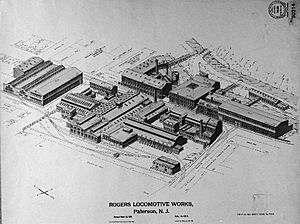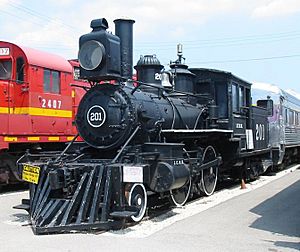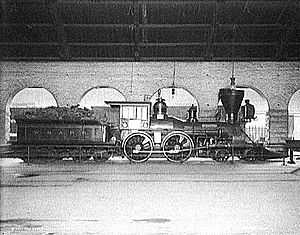Rogers Locomotive and Machine Works facts for kids

An aerial view drawing of the Rogers Locomotive Works plant on March 28, 1906
|
|
| Industry | Rail transport |
|---|---|
| Fate | Merged |
| Successor | ALCO |
| Founded | 1832 (as Rogers, Ketchum and Grosvenor) |
| Founders | Thomas Rogers, Morris Ketchum and Jasper Grosvenor |
| Defunct | 1905 |
| Headquarters |
,
United States
|
| Products | Steam locomotives and rolling stock |
Rogers Locomotive and Machine Works was a famous company that built steam locomotives in the 1800s. It was located in Paterson, New Jersey, in the United States. This company made over 6,000 steam locomotives for railroads all around the world. Many U.S. railroads in the 19th century had at least one locomotive made by Rogers.
One of their most famous locomotives was The General. It was built in December 1855 and played a big part in the Great Locomotive Chase during the American Civil War.
The company started in 1832. It was first called Rogers, Ketchum and Grosvenor. It was founded by Thomas Rogers, Morris Ketchum, and Jasper Grosvenor. Thomas Rogers was the president until he passed away in 1856. His son, Jacob S. Rogers, then took over. He renamed the company Rogers Locomotive and Machine Works. Jacob led the company until he retired in 1893.
After Jacob retired, Robert S. Hughes became president. He changed the company's name to Rogers Locomotive Company. He was in charge until he died in 1900. Rogers tried to stay independent when many locomotive companies merged to form the American Locomotive Company (ALCO) in 1901. But ALCO bought Rogers in 1905.
ALCO kept building new steam locomotives at the Rogers factory until 1913. They used the buildings for storage until the 1920s. Today, many Rogers-built locomotives are in museums. The original factory building, called the Thomas Rogers Building, is now the Paterson Museum. This museum shows the industrial history of Paterson.
Contents
How Rogers Locomotive Works Began (1831-1856)
The company that became Rogers Locomotive Works started in 1831. Thomas Rogers had been designing machines for making textiles for almost 20 years. In June 1831, he started his own company called Jefferson Works in Paterson, New Jersey. At first, Jefferson Works made machines for textiles and farming.
In 1832, Rogers teamed up with two investors from New York City: Morris Ketchum and Jasper Grosvenor. The company was renamed Rogers, Ketchum & Grosvenor. They started making parts for railroads, like springs and axles.
The first locomotive Rogers' company put together was actually made by Robert Stephenson and Company in England in 1835. It was called the McNeil for the Paterson and Hudson River Railroad. It took two more years for Rogers to get an order for a full locomotive.
In 1837, the Mad River and Lake Erie Railroad ordered two locomotives from Rogers. The first of these was the Sandusky. This locomotive was the first to cross the Allegheny Mountains. It was also the first locomotive to run in Ohio.
Sandusky had new features designed by Thomas Rogers. It was the first locomotive to use cast iron driving wheels. These wheels had special weights to make them run smoother on the tracks. Before Sandusky, driving wheels were often made of wood.
Rogers also worked with other locomotive builders. In 1837, he made parts for Matthias W. Baldwin (who started Baldwin Locomotive Works) and William Norris (who started Norris Locomotive Works). But once Rogers started building his own locomotives, these orders stopped.
Many talented engineers worked at Rogers. William Swinburne was a shop foreman before starting his own company in 1845. John Cooke also worked there and later started his own locomotive company. Zerah Colburn was a well-known engineer who made improvements to locomotive design around 1854. His assistant, William S. Hudson, took over after Thomas Rogers died in 1856. Hudson stayed with Rogers until his death in 1881.
Rogers locomotives were known for being powerful. For example, the Uncle Sam, built in 1839, could pull a 24-car train up a hill at 24.5 miles per hour (39.4 km/h). In 1846, Rogers built the Licking, which could pull a 380-ton train up a hill.
The most famous locomotive from Rogers was built in 1855. It was a 4-4-0 type locomotive, serial number 631. The Western and Atlantic Railroad named it The General. This locomotive is famous for its role in an American Civil War event. Today, you can see The General at the Southern Museum of Civil War and Locomotive History in Kennesaw, Georgia.
Rogers locomotives were also known for lasting a long time. One locomotive, Illinois Central Railroad number 23, ran for over one million miles (1.6 million km) in 30 years!
Changes and Decline of Rogers (1856-1905)
When Thomas Rogers died in 1856, his son Jacob S. Rogers took charge. He renamed the company Rogers Locomotive & Machine Works. The company continued to make both locomotives and textile machines for almost 20 more years.
In 1863, Rogers built its first 2-6-0 type locomotive. This was possibly the first 2-6-0 built in the United States.
In November 1868, Rogers delivered five coal-burning locomotives to the Union Pacific Railroad. One of these, Union Pacific No. 119, became famous on May 10, 1869. It was part of the "Golden Spike" ceremony in Promontory, Utah. This event celebrated the completion of the First Transcontinental Railroad. Locomotive No. 119 was used for nearly 35 years before it was retired in 1903. Today, a working copy of No. 119 is on display at the Golden Spike National Historical Park.
In the mid-1870s, Rogers stopped making textile machinery. They focused only on building locomotives. The Louisville and Nashville Railroad (L&N) bought so many locomotives from Rogers that they received a free one in 1879 as a thank you!

Reuben Wells became the shop superintendent in 1887. Jacob Rogers, who was getting older, slowly gave more responsibility to Wells. Jacob resigned as president in 1893. The company was then reorganized as the Rogers Locomotive Company. For the first time in over 60 years, a Rogers family member was not running the company.
Robert S. Hughes, who was the company's treasurer, became the new president. Jacob Rogers remained the main investor. Hughes led the company until he died in 1900. A year later, Jacob Rogers closed the Rogers Locomotive Company factory.
In 1901, the same year Jacob Rogers died, the American Locomotive Company (ALCO) was formed. ALCO was a big company created by merging eight other locomotive makers. Rogers Locomotive Company reopened as the Rogers Locomotive Works. Reuben Wells was again the shop superintendent. However, Rogers was at a disadvantage. They didn't invest enough money in new equipment or research. ALCO and Baldwin were much bigger and had a lead in making and selling locomotives. Rogers also had trouble because there was no nearby train connection. This made it hard and slow to transport materials and locomotives.
Rogers Joins ALCO (1905-Present)
Because of strong competition and not being able to grow, ALCO bought Rogers Locomotive Works in 1905. The last locomotive Rogers built on its own was serial number 6271. It was a 0-6-0 tank locomotive made in February 1905.
ALCO continued to build locomotives at the Rogers factory until 1913. After that, no more locomotives were made there. Locomotives built at the Rogers plant under ALCO are called ALCO-Rogers. ALCO used the Rogers factory buildings as warehouses until the 1920s. Eventually, they sold all the property. The original Rogers building where locomotives were put together was turned into offices.
This building is now called the "Thomas Rogers Building." It is home to the Paterson Museum. The museum shows items from Paterson's industrial past. Outside the museum, you can see a 2-6-0 locomotive that helped build the Panama Canal. This locomotive was made by ALCO-Cooke, which was another factory in Paterson, not by Rogers itself.
Rogers Locomotives You Can Still See Today
Many locomotives built by Rogers are still around! Here are some of them, in order of when they were built. All locations are in the United States unless noted.
| Serial number | Type of locomotive (Whyte notation) |
Built in | Who owned it | Where it is now |
|---|---|---|---|---|
| 42 | 4-2-2 | March 1843 | Matanza Railroad No. 1 | Christina Station, Havana, Cuba. |
| 631 | 4-4-0 | December 1855 | Western and Atlantic Railroad No. 3 General | Southern Museum of Civil War and Locomotive History, Kennesaw, Georgia. |
| 812 | 4-4-0 | January 1858 | Atlantic and Gulf Railroad No. 3 | Henry Ford Museum, Dearborn, Michigan |
| 1757 | 4-4-0 | June 1870 | Eten Ry No. 2 "Althaus" | Remains preserved at Eten, Peru. |
| 1814 | 0-(2)2-0T - steam car | November 1870 | Eten Ry "El Guainambi" | Remains preserved at Eten, Peru. |
| 2454 | 2-4-2 | July 1877 | New Zealand Railways NZR K 88 | The Plains Vintage Railway & Historical Museum, Ashburton, New Zealand. |
| 2468 | 2-4-2 | March 1878 | New Zealand Railways K No. 92 | Waimea Plains Railway, Gore, New Zealand. |
| 2470 | 2-4-2 | March 1878 | New Zealand Railways K No. 94 | The Plains Vintage Railway & Historical Museum, Ashburton, New Zealand. |
| 2588 | 2-4-4T | May 1880 | Illinois Central Railroad #201 | Illinois Railway Museum, Union, Illinois. |
| 3327 | 4-4-0 | August 1883 | Canadian Pacific Railway No. 136 | South Simcoe Railway, Tottenham, Ontario, Canada. |
| 4493 | 4-6-0 | March 1891 | Prescott and Arizona Central Railway No. 3, Sierra No. 3 | Railtown 1897 State Historic Park, Jamestown, California; it still runs! |
| 4788 | 4-6-0 | November 1892 | Burlington and Missouri Railroad No. 309, Chicago, Burlington and Quincy Railroad No. 637 | Illinois Railway Museum, Union, Illinois. |
| 4865 | 0-6-0ST | 1893 | Chilean State Railways Type 22 No. 205 | Santiago Railway Museum, Santiago, Chile. |
| 5086 | 4-6-0 | 1896 | Chilean State Railways Type 38 No. 248 | Hotel Las Acacias de Vitacura, Santiago, Chile. |
| 5001 | 2-4-0 | 1894 | MINAZ No. 1216 | Cuba Libre Sugar Mill, Pedro Betancourt, Cuba. |
| 5425 | 0-6-0 | September 1899 | St. Paul and Duluth Railroad No. 74, Northern Pacific No. 924 | Northwest Railway Museum, Snoqualmie, Washington. It still runs! |
| 5609 | 4-6-0 | August 1900 | Mobile and Ohio Railroad No. 187, Columbus and Greenville Railway No. 178 | Propst Park, Columbus, Mississippi. |
| 5190 | 2-8-0 | 1901 | Chilean State Railways Type R No. 3087 | Santiago Railway Museum, Santiago, Chile. |
| 5796 | 2-8-0 | August 1902 | Great Northern Railway No. 1147 | North Central Washington Museum, Wenatchee, Washington. |
| 6178 | 2-8-0 | June 1904 | Illinois Central Railroad No. 764 | National Museum of Transportation, Kirkwood, Missouri. |
| 6256 | 4-6-2 | January 1905 | Louisville and Nashville Railroad #152 | Kentucky Railway Museum, New Haven, Kentucky. |
| 6259 | 0-6-0 | January 1905 | Atlanta and West Point Railroad No. 4, Western Railway of Alabama No. 104 | Georgia RR Depot, Conyers, Georgia. |
Here are some locomotives built by ALCO at the Rogers plant after ALCO bought the company:
| Serial number | Type of locomotive (Whyte notation) |
Built in | Who owned it | Where it is now |
|---|---|---|---|---|
| 6178 | 2-8-0 | 1904 | Illinois Central Railroad #764 | National Museum of Transportation, Kirkwood, Missouri. |
| 53115 | 0-4-0T | June 1913 | Los Angeles Harbor Department No. 32 | Travel Town Museum, Griffith Park, Los Angeles, California. |
| 53880 | 0-4-0T | June 1913 | Macon Iron & Paper Stock No. 30 | Georgia State Railroad Museum, Savannah, Georgia. |
See also
 In Spanish: Rogers Locomotive and Machine Works para niños
In Spanish: Rogers Locomotive and Machine Works para niños



